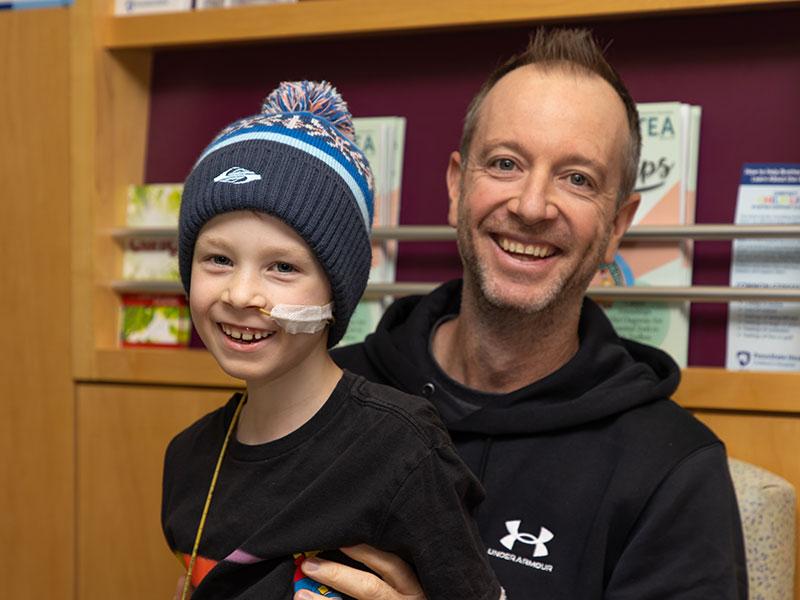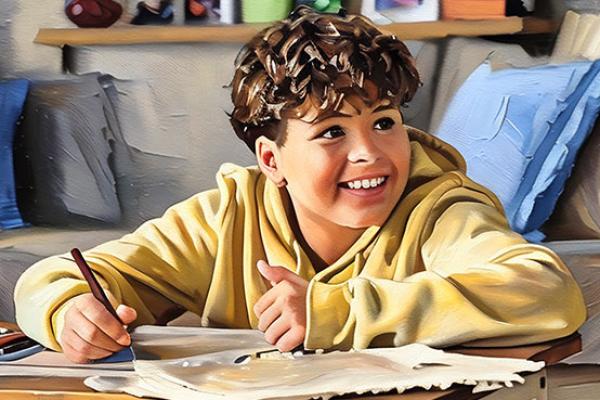
The global quest: Australia’s Jack family finds hope for son’s neuroblastoma in Hershey
By Bill Landauer
“Is there a cure?” Russell Jack wanted to know.
When he’d left his home in Bindoon, Australia, for the North West region weeks earlier, his 6 year-old son Bryson was sick. The boy had been asking to go to bed early, and for a pint-sized ball of energy already obsessed with motocross racing, running and camping, that seemed out of character. He’d had a lump on the crown of his head that pediatricians couldn’t explain. It was probably just one of those bumps and bruises rough-and-tumble kids sometimes accumulate, they said.
But when Russell, who had to leave on an extended business trip, returned, Bryson’s condition had become dire. He was suffering from blinding headaches, had lost weight and couldn’t keep any food down. For days, doctors sought the cause. When Russell took Bryson on an hour and 30-minute drive south from his home in the rolling acres of eucalyptus trees to a children’s hospital in the city of Perth, they found it.
“Neuroblastoma,” the doctors explained. It was already Stage 4. The lump was the outer edge of one of the tumors that had already flared like wildfires throughout the boy’s tiny frame.
Russell, who’d built his own construction business in his hometown of 1,200 people, is well-versed in finding answers to hard questions. So, he asked the oncologist, “Is there a cure?”
“There’s a treatment,” the doctor told him.
“It didn’t sit well with me,” he says. That conversation – one of the most pivotal of his life – was almost two years ago. On this day in early June, he’s seated in a coffee shop in the lobby of the Hershey Lodge, 11,000 miles from home. Bryson, now 7, tussles comically nearby with his 10-year-old sister Madeline, over a flip-flop.
The family is still on the quest Russell’s question had become that day in 2022, one that took him and his family from Australia and Europe before bringing him finally here to rural Pennsylvania. At Penn State Health Children’s Hospital with a woman whose name had been popping up in articles and blog posts from the beginning of his search - Dr. Giselle Saulnier Sholler - Russell has found the hope for which he’d been searching the world over.
Hope that the treatment the oncologist had mentioned, which turned out to be so intense it confined his little boy to a wheelchair and seemed to bring him to the brink of death, is finished.
Hope that neuroblastoma, the notoriously aggressive cancer he’d watch kill children and shred entire families in Australia, is gone for good.
Hope that his global fight had been worth it at last, and that he and his boy had finally attained what they set out for in the first place. A future.
‘I read’
Russell found Sholler’s name within two weeks of hearing Bryson’s diagnosis. By then, neuroblastoma was all he could think about. He read anything he could get his hands on about the subject. “Dr. Sholler,” he learned quickly, “is considered neuroblastoma royalty.”
Sholler had been focused for her entire career on finding an answer to neuroblastoma. About 700 to 800 children are diagnosed with the cancer every year. For some children, survival rates are as low as 40%, and once it forms, the illness is often hard to dislodge. Tumors removed surgically or degraded through chemotherapy radiation flare up again elsewhere.
But Sholler had found what was beginning to look like promising news a drug called eflornithine (DFMO) seemed to stop the cancer from starting again.
At the time Russell began reading, Sholler was a physician at a hospital in North Carolina, thousands of miles from where Bryson had started on treatment in Perth. After receiving his first chemotherapy on Nov. 19, 2022, he stayed in the hospital for four weeks until doctors declared him stable enough to go home.
Russell moved to Perth, leaving his wife and two other children behind in Bindoon, seeing them only when they visited on weekends. When he wasn’t by Bryson’s bedside, he continued reading everything he could find. “I’d fall asleep with the phone on my face,” he said. “I read. Read all the time. Read when I was driving – I know I shouldn’t have.”
At the hospital, he befriended the family of a 2-year-old girl who lived on the same floor as Bryson who was also suffering from neuroblastoma and getting the same treatment. When the child died, the news shook him.
Russell, who has remained friends with the family, went to her funeral. “It was hard,” he said, “making up a story about where I was going that day, smiling to Bryson and pretending everything was OK.” He didn’t tell Bryson right away that the little girl they’d met with the same illness hadn’t made it.
In early 2023, Bryson started what would turn into four more cycles of chemo. On March 9 of that year, doctors performed a 10-hour surgery that would remove 98% of the remaining primary tumor cells. After that came more chemo, a stem cell transplant, radiation therapy, and finally immunotherapy.
“He took it like a champion and rarely complained about it,” Russell said. But the treatment left the boy weak. He lost more weight. He was unable to walk and wound up in a wheelchair.
And while he responded well to what they tried, Russell felt the damage it was doing was life threatening. It had already affected Bryson’s hearing. What other permanent damage was it doing? Would he be able to have children?
Meanwhile the lingering fear of neuroblastoma’s most frightening of characteristics remained. Sometimes pretty often, actually it comes back.
Hope in the U.S.
Russell continued to read up on neuroblastoma. He read about other parents in Australia who had children who had met Sholler and started taking DFMO.
He sought a second opinion from Professor Jaume Mora, a neuroblastoma expert from Barcelona, Spain. Mora’s advice “gave me the confidence to alter Bryson’s course of treatment.” He opted against another round of myeloablative chemotherapy and second stem cell transplant. At the time, Mora’s hospital in Spain was a candidate to become a DFMO test site, and Mora assured Russell if that happened by the time Bryson had finished front line treatment, Bryson could go there.
Meanwhile, in Bindoon the community rallied. Bryson’s teacher who had just retired had agreed to tutor the boy to get him through the school that he’d missed. He began to recover from months of continued therapy.
Then, in September 2023, Russell learned that Sholler had moved her work to Penn State Health Children’s Hospital. He thought of the fabled rollercoasters and waterslides of the nearby monument to fun, Hersheypark. If ever a family needed a break like that, it was the Jacks.
It all seemed perfect.
The answer at last
On Oct 3., 2023, Russell exchanged emails with Suzanne Treadway, a registered nurse in pediatric oncology at Penn State Health Children’s Hospital, who helped him set up an appointment with the doctor he’d been reading about for months.
After an online consultation, the family found themselves flying around the globe for their first appointment on Dec. 6, 2023, with Sholler.
Sholler has met many families who have gone through similar searches. She festoons the walls of her office with images of some of the patients she’s helped throughout a career battling neuroblastoma. “They will do anything for their kids,” she said.
Bryson was in remission by the time he visited the U.S. “The goal is to keep him in remission,” Sholler said.
So far, it’s working. Side effects to DFMO are minor.
“He has a bit of dry skin,” Russell says, stopping to try to distract the towheaded boy as he wrestles his sister. They are back on this day in June on their third trip to Hershey. On this day, they’re planning to go to the park, hence the T-shirts and sneakers and flip-flops. The flights to get here are long – usually it takes a day in transit, though one recent trip was a nightmare that lasted three – and the family doesn’t have to try hard to find adventure here.
Bryson has aged two years according to the calendar. He seems older, Russell said, as if he has gathered wisdom from the same tubes that delivered the poisons that killed the cancer.
Russell is wiser, too. “Read lots,” he says, “surround yourself with the best people and institutions to ensure you get what your child needs.”
The possibility that the cancer might come back still plagues his nightmares, but he rests easy knowing his global quest brought him an answer – maybe not the simple one he wanted, but a better one than before.
Is there a cure? he wanted to know.
There’s a hope.





